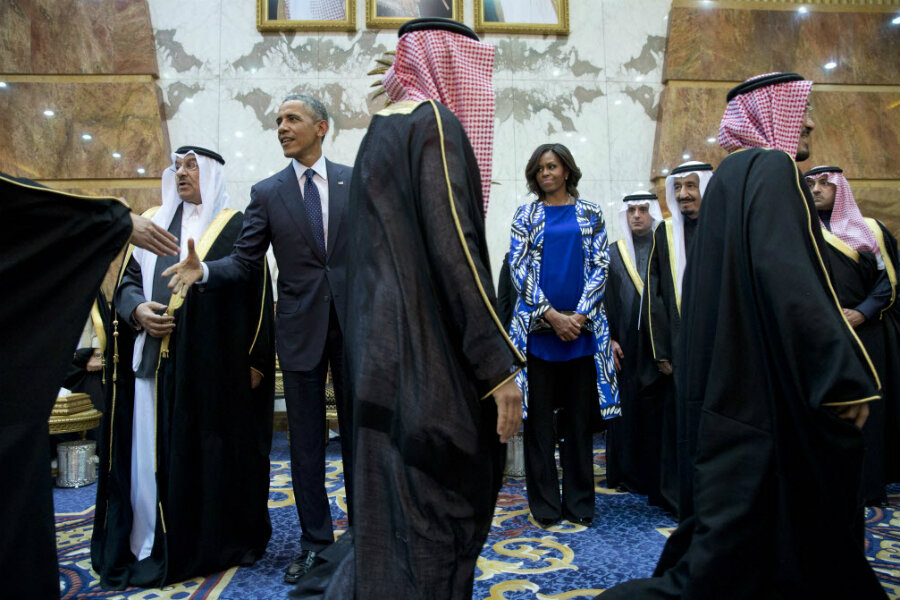Michelle Obama forgoes head scarf in Saudi Arabia. Faux pas?
Loading...
| WASHINGTON
The local social media uproar over Michelle Obama’s clothing choices in Saudi Arabia illustrates a truism of top-level diplomacy: Protocol is difficult to manage, even if you’re prepared.
But no, as far as we can tell, Saudi state TV did not, in fact, blur out the first lady’s image during a broadcast of her and President Obama meeting the new Saudi king, due to the fact that she did not wear a covering head scarf.
And many other Western women have dressed in a similar manner when meeting Saudi royalty on their home ground, including former first lady Laura Bush.
Here’s the background on what happened. President and Mrs. Obama made a short stop in the Saudi kingdom on Tuesday to show respect for the late King Abdullah and to meet with the new King Salman bin Abdul-Aziz.
The Saudi kingdom is one of the most socially conservative nations in the world, particularly when it comes to women’s public roles. Saudi women can’t drive. They typically are completely covered outside their own homes, with head coverings, veils, and full flowing black robes.
You can bet Mrs. Obama knew this, and that she or somebody on her staff had put a lot of thought into how she would dress and behave in this environment. Westerners aren’t required to cover their heads in the kingdom, so in the receiving line at the palace, the first lady didn’t. She wore a flowing blue printed robe over a blue blouse and dark pants.
When she was first lady, Laura Bush went uncovered when meeting the Saudi king in 2007. Former Bush administration Secretary of State Condoleezza Rice was in the US delegation on Tuesday, and she did not wear a headscarf, either.
Still, was the first lady making a point about the late king’s legacy on women’s rights? Most likely she was.
“Keep in mind that Obama does not make fashion choices lightly, particularly on the world stage,” writes Nia-Malika Henderson at the Washington Post’s political blog, "The Fix."
Nor did Mrs. Obama behave in an overtly deferential manner. At the receiving line at the airport, she walked slightly behind her husband, clutching a purse in her hands. If the Saudi man opposite her initiated the move, she shook hands and smiled, according to reporters who were present. If the man simply nodded at her politely, she did the same, refraining from touching.
This is pretty daring stuff for Saudi Arabia. On Twitter, many Saudis criticized her lack of veil, with more than 1,500 comments piling up on an Arabic hashtag that translates #Michelle_Obama_NotVeiled, according to the English language website of the Egyptian newspaper Al Ahram.
There were initial reports that Saudi TV simply blotted out the first lady’s image when airing the receiving lines. But those were denied by the palace, and some Western journalists reported that they had seen unblurred broadcasts of the events.
This tempest in an Arabia teapot is not unusual for a US president or, indeed, for any world leader visiting a nation with different cultures. It is hard to accommodate all local sensibilities. In 2009, when Michelle Obama met Queen Elizabeth, she hugged her. This drew outrage from some British tabloids. Nobody is supposed to touch the Queen on such an occasion, apparently.
Meeting the Japanese emperor poses something of a reverse problem. In Japan it is typical to bow to show reverence. But it can be controversial for a US president to make such a move.
Obama got in trouble with some critics for appearing to bow to Emperor Akihito in 2009. Former President George H. W. Bush was similarly criticized for bowing to the casket of Emperor Hirohito, Japan’s titular leader in World War II.
However, George H. W. Bush of all presidents probably has earned the right to behave as he wants in Japan. After all, he was shot down in the Pacific as a young Navy flyer in 1944.








